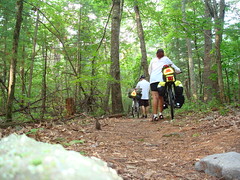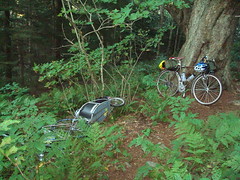Archive
Not Eating Wild Things Today: Stinging Nettles
So how dumb do you have to be to stick something in your mouth that has “stinging” as part of its name? Well pretty dumb according to my wife, but growing up a poor kid in Southern Appalachia we ate all manner of weird things, and were happy to get it. Nettles were one of those weird things. Yep, they really do sting. Not so much as to cause you to drop to the ground writhing in pain, but enough to make you let go. Honestly I enjoy being stung by nettles. I find it exciting, almost electrifying, to a point. Usually when my throat starts to swell shut I know I’ve had enough and I get up, put my clothes back on and stop wallowing in it. Then I pick some of the plants that have not been too wallowed and bring them home to cook. But no such luck today. The search continues!
Eating Wild Things: Wild Carrots
Wild Carrots (Queen Ann’s Lace) can be found growing in open fields and roadsides throughout most of America. Poison Hemlock can be found growing in open fields and roadsides throughout most of America. The way to tell them apart is that one will kill you. Just ask Socrates. So unless you are absolutely sure you are about to eat a Wild Carrot, or you have just been convicted of impiety and hell bent on ending it all, DO NOT EAT WILD CARROTS. This is where a good field guide can save you from irreversible liver damage. Many tasty wild things look similar to many deadly wild things. Even a small amount of Poison Hemlock can cause paralysis and death.
If you do choose to eat a Wild Carrot, find a young plant. The large one in my photo is too large and is woody and tough. The small ones are still tender, but as you can see, are really too small to use as anything but a tasty treat. The roots of Queen Ann’s Lace taste and smell like the carrot you’re used to, but have a woody outer skin.
One last time, whatever you do, DO NOT EAT WILD CARROTS.
Thanks for reading, Jack
Eating Wild Things: Wild Mountain Mint
Once you’ve trained your eye to spot this refreshing herb, you’ll start to see it everywhere. Mint is very hardy and grows in large patches both trailside and roadside. Recognize it by its square stem, paired leaves and of course, smell. There are several varieties from Horse Mint to Bee Balm aka: Oswego-Tea. Each has it own flavor and scent. As you ride (or hike) along, pluck off a handful of leaves and stuff them back. A mesh goodie bag is a nice thing to collect mint and berries throughout your day. Or just collect them stem and all and attach the bundle to your pannier.
You can use mint to season food, but I don’t think it very handy when touring or hiking. I think it is best as a tea. Seep the leaves in hot water to make a delicious caffeine free tea or let the leaves soak in your water bottle for a few hours to pep up that nasty water you got out of the gas station sink. Save a few sprigs to hang in your tent for some well needed aroma therapy to cure road-fatigue. Folklore has it that wild mint can revive the dead…so use with caution around pet cemeteries.
Thanks for reading, Jack
Eating Wild Things: Ramps
A few terms you’ll need to know before you get started:
- “Ramp’n” – verb. The activity of hunting and digging Ramps.
- “A mess” – noun. Just enough for one meal.
- “A poke” – noun. A bag, usually a shopping bag, used to carry “a mess”.
- “Stank” – adjective. The odor given off by Ramps.

Ramps are a celebrated wild leak-like plant here in southern Appalachia. Spring Ramp festivals draw large crowds to small mountain towns from North Georgia, North Carolina and intoVirginia. With a lingering odor, once you’ve tasted a Ramp all your friends and neighbors will know. The more mature the Ramp, the more pungent the aroma. Ramp season is early spring and the higher the elevation the later the season. The activity of collecting Ramps is known as “Ramping”. Ramps are so sought after, they are becoming hard to find.
So here are a few tips for ethical Ramping:
- Don’t be greedy. Take only what you intend to eat.
- Never dig out a whole patch. Only take a few and leave the rest to multiply.
- Be careful where you step. Don’t trample young plants.
- Be sure it is legal to collect plants in the area you are digging.
- And of course, leave no trace. If you dig a hole, fill it in and rake the ground cover back.

There are a lot of ways to prepare Ramps. My favorite is to fry them with potatoes. One or two Ramps are plenty and I use the whole plant, leaves and all. With older plants the leaves may be too wilted to use for cooking. Once cleaned and ready for the knife, dice into tiny pieces and lightly toast in olive oil. Throw in cubed potatoes and brown. There is no wine in the civilized world robust enough to accompany Ramps, but a stout black ale is perfect. Here’s a typical southern Appalachian meal. Ramps and potatoes, corned beef and cabbage and corn bread cooked in an iron skillet.
Enjoy, Jack
Eating Wild Things: Polk Salad
Whatever you do, don’t eat Polk Salad. It is both delicious and toxic. All parts of the plant are toxic. I’ve been eating Polk Salad since childhood and apart from some drain bamage, I seem to be okay, but why risk it.
From Wikipedia ~ the source of all wisdom
“Ingestion of poisonous parts of the plant may cause severe stomach cramping, nausea with persistent diarrhea and vomiting, sometimes bloody, slow and difficult breathing, weakness, spasms, hypertension, severe convulsions, and death. However, consuming fewer than 10 uncooked berries is generally harmless to adults. Several investigators have reported deaths in children following the ingestion of uncooked berries or pokeberry juice. Severe poisonings have been reported in adults who ingested mature pokeweed leaves and following the ingestion of tea brewed from one-half teaspoonful of powdered pokeroot.”
Okay, you’ve been properly warned.
Find Polk Salad (aka: pokeweed, poke) growing throughout the south along roadsides and in open fields. Polk grows in full sun. It is a true weed and will grow in the poorest of soils and hard packed clay.
I boil my Polk Salad, drain and rinse thoroughly before cooking. I also use only young plants and I usually stay away from the stems (although admittedly I have fried young stems like okra). Also, I only prepare a small portion. I cook them with scrambled eggs and make a kind of Polk Salad omelet. I season with a bit of salt and ground pepper and nothing more.
The flavor is similar to spinach or turnip greens, although with spinach or turnip greens you don’t risk killing yourself and they are available at your local produce stand. The reason I eat Polk Salad is for the fond memories it stirs up of my childhood. Perhaps my folks fed it to us intending to thin out the herd and cull out the weak among us. For whatever reason, it instilled a passion for the poisonous Polk.
Whatever you do, do not eat Polk Salad, Jack
Eating Wild Things
Spring has sprung here in the Smoky Mountains and life is sprouting from every spare patch of dirt. In amongst the poison ivy and rag weeds are some tasty treats. From Ramps and Polk Salad to mushrooms and berries, the mountains are filled with edible plants. Over the next few months I’ll share a few of my favorites as they come into season. Some of my fondest memories are of my three spinster Great-Aunts who lived in a small cinder-block house tucked away in one of the countless Appalachian hollows (pronounced “hollers”). They cooked on a wood stove, planted their crops by the signs of the zodiac, adhered to age-old superstitions and supplemented their diet with wild things. They lived to very ripe old ages and remained unmarried, having no need for the likes of men. Looking back now, I wonder if they were not more progressive than I give them credit, but I’m going off topic. The point is, as a youngster, they fed me wild things. Ramps, Polk Salad and Mountain Watercress are the three that stand out in memory.
Whatever you do, do not eat plants based on anything I post. I do not know what I’m doing and it’s a wonder I have not poisoned myself. If you intend to eat wild things, get yourself a good field guide, like ‘Edible Wild Plants’ by Lee Allen Peterson. Also consider finding an old person who has been eating wild things for several decades, has a few teeth left and does not look too jaundiced. Chances are, they are not consuming poisonous plants and know what they are doing. If nothing else, let a friend eat the plant first, then sit back and observe him for ill effects before trying it yourself. I’ve spotted some tasty Polk Salad growing in the meadow in front of my house. We’ll start with that in a few days.
Jack











 "Hey Buffy, that looks like the Brooks saddle you ate last week"
"Hey Buffy, that looks like the Brooks saddle you ate last week" 









